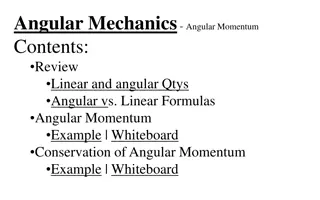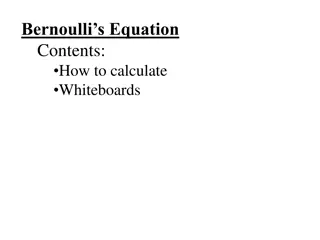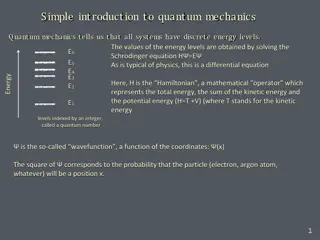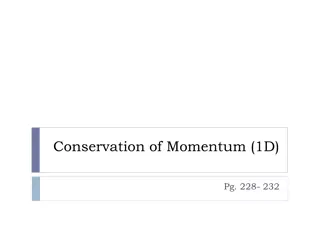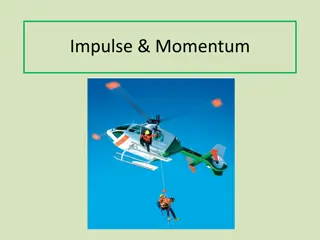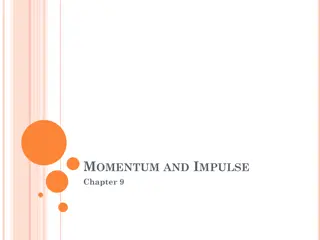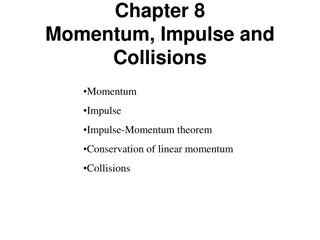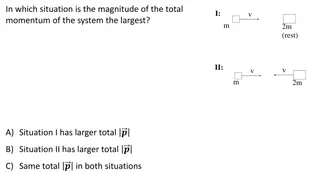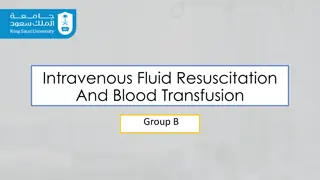Application of the Momentum Equation in Fluid Mechanics
Explore examples of applying the momentum equation in fluid mechanics, including calculating forces in pipe bends, nozzles, impacts on surfaces, and around vanes. The analysis involves determining total force, pressure force, and resultant force through control volume diagrams and coordinate axis systems.
Download Presentation

Please find below an Image/Link to download the presentation.
The content on the website is provided AS IS for your information and personal use only. It may not be sold, licensed, or shared on other websites without obtaining consent from the author. Download presentation by click this link. If you encounter any issues during the download, it is possible that the publisher has removed the file from their server.
E N D
Presentation Transcript
Application of the Momentum Equation We will consider the following examples: 1. Force due to the flow of fluid round a pipe bend. 2. Force on a nozzle at the outlet of a pipe. 3. Impact of a jet on an inclined plane surface. 4. Force due to flow round a curved vane.
The force due the flow around a pipe bend Consider a pipe bend with a constant cross section lying in the horizontal plane and turning through an angle of
Because the fluid changes direction, a force (very large in the case of water supply pipes,) will act in the bend. If the bend is not fixed it will move and eventually break at the joints. We need to know how much force a support (thrust block) must withstand. Step in Analysis: 1. Draw a control volume 2. Decide on co-ordinate axis system 3. Calculate the total force (rate of change of momentum) 4. Calculate the pressure force 5. Calculate the body force 6. Calculate the resultant force
The control volume is draw in the above figure, with faces at the inlet and outlet of the bend and encompassing the pipe walls. It is convenient to choose the co-ordinate axis so that one is pointing in the direction of the inlet velocity. In the above figure the x-axis points in the direction of the inlet velocity.
Calculate the total force: In the x-direction: = ( ) F Q u u 2 1 tx x x = u u 1 1 x = cos u Q u u 2 2 x = ( cos ) F u 2 1 tx In the y-direction: = ( ) F Q u u 2 1 ty y y = = sin 0 0 u u 1 1 y = sin u u 2 2 Qu y = sin F 2 ty
Calculate the pressure force F p = pressure force at 1 - pressure force at 2 Fpx= p1A1cos 0 p2A2cos = p1A1 p2A2cos Fpy= p1A1sin 0 p2A2sin = p2A2sin Calculate the body force There are no body forces in the x or y directions. The only body force is that exerted by gravity (which acts into the paper in this example - a direction we do not need to consider). Fbx= Fby= 0
Calculate the resultant force FRx= Ftx- Fpx -Fbx FRy= Fty- Fpy- Fby = = + + 0 ( cos ) cos F F F Q u u p A p A 2 1 1 1 2 2 Rx Tx px = = 0 sin sin F F F Qu p A 2 2 2 Ry Ty py
And = + 2 2 resul F F F tan t Rx Ry F Ry = 1 tan ( ) F Rx The force on the bend is the same magnitude but in the opposite direction R = - Fresultant
Force on a pipe nozzle Force on the nozzle at the outlet of a pipe. Because the fluid is contracted at the nozzle forces are induced in the nozzle. Anything holding the nozzle (e.g. a fireman) must be strong enough to withstand these forces.
The same analysis will be followed as before. Step in Analysis: 1. Draw a control volume 2. Decide on co-ordinate axis system 3. Calculate the total force 4. Calculate the pressure force 5. Calculate the body force 6. Calculate the resultant force
1 & 2 Control volume and Co-ordinate axis are shown in the figure above. 3 Calculate the total force = = ( ) F F Q u u 2 1 T Tx Using the continuity, Q = A u 1 A 1 A = 2 ( ) FTx Q 2 1
4 Calculate the pressure force Fp= Fpx= pressure force at 1 - pressure force at 2 2 1 2 2 p u 2 p u 2 + + = + + + 1 2 z gz fh 1 2 g g g g Friction is neglected for short distance and the nozzle is horizontal i.e. z1and z2are equal and p2is atmospheric i.e. 0 and with continuity = 2 1 A 1 A Q ( ) p 1 2 2 2 2 1
5 Calculate the body force The only body force is the weight due to gravity in the y- direction - but we need not consider this as the only forces we are considering are in the x-direction. 6 Calculate the resultant force = F F F F Rx Tx px Bx = 0 F F F Rx Tx px 2 1 A 1 A 1 A 1 A Q = 2 ( ) ( ) FTx Q 2 2 2 2 2 1 1


